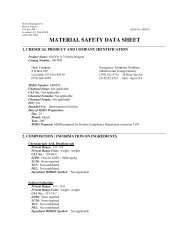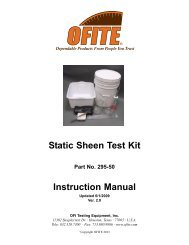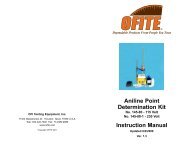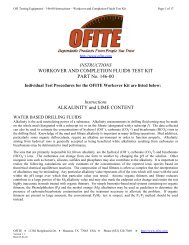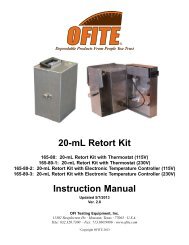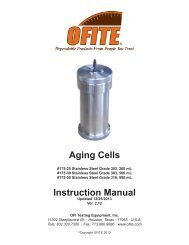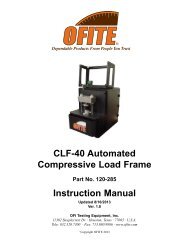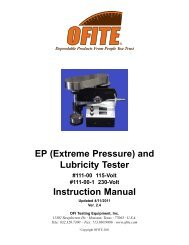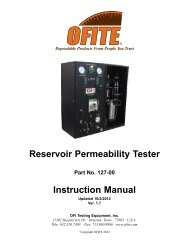Create successful ePaper yourself
Turn your PDF publications into a flip-book with our unique Google optimized e-Paper software.
<strong>OFI</strong> <strong>Testing</strong> <strong>Equipment</strong> – 144-20 Instructions – Rig Lab Page 1 of 6<br />
http://www.ofite.com<br />
INSTRUCTIONS<br />
RIG LABORATORY, <strong>OFI</strong>TE<br />
PART No. 144-20<br />
<strong>OFI</strong>TE • 11302 Steeplecrest Dr. • Houston, TX 77065 USA • Phone (832) 320-7300 • http://www.ofite.com<br />
Version 1.2<br />
Date 10-27-05
<strong>OFI</strong> <strong>Testing</strong> <strong>Equipment</strong> – 144-20 Instructions – Rig Lab Page 2 of 6<br />
The Rig Lab permits the following analyses:<br />
Marsh Funnel -Viscosity<br />
Mud Balance -Density<br />
Filter Press -Filtration Control<br />
Sand Content -Percent (%) Sand<br />
Chloride -Titration method<br />
PH <strong>Testing</strong> -pH Paper<br />
Components:<br />
#110-10 Marsh Funnel Viscometer<br />
#110-20 Measuring Cup, 100 ml<br />
#115-00-11 Mud Balance, metal, less case<br />
#140-10 Filter Press, Wall Mount, Components<br />
#140-55 Filter Paper, 3 ½”, 100 / pkg<br />
#141-00 Cell Body<br />
#141-01 Base Cap<br />
#141-02 Top Cap<br />
#141-04 Screen, 60 mesh<br />
#141-05 Gasket, for cell, Neoprene<br />
#141-07 Frame, bare, wall mount<br />
#141-09 Threaded Insert, for T-screw<br />
#141-10 T-screw<br />
#141-13 Air Hose, low pressure, 1 foot<br />
#141-16 Support, for Graduate Cylinder<br />
#141-19 Adapter, for Top Cap to Air Hose<br />
#141-22 Felt Filter, for Top Cap inlet<br />
# 142-10 CO 2 Pressure Assembly Components<br />
#143-00 Regulatgor, Concoa® (Airco)<br />
#143-01 Gauge, 200 psi, 1/8” connection<br />
#143-02-10 Puncture Head Assembly, for CO 2<br />
#143-03 Barrell, for CO 2 bulb<br />
#143-06 Safety Bleeder Valve<br />
#144-12 Elbow, male, 90 degree, ¼”<br />
#144-25 Air Manifold<br />
#167-00 Sand Content Analysis Components:<br />
#167-10 Sieve, 200 mesh<br />
#167-20 Funnel<br />
#167-30 Graduated Tube, glass, 0 – 20%<br />
Labware:<br />
#147-50 pH Paper, dispenser, 2-10, 1-11<br />
#147-70 pH Paper, dispenser10-12, 12.5-14<br />
#153-01 Bottle Brush, wood handle, 3” x 12”<br />
#153-03 Brush for Grad. Cylinder, ½ x 8”<br />
#153-16 Graduate Cylinder, 25 ml x 2/10 ml<br />
#153-18 Graduate Cylinder, 10 ml x 2/10 ml<br />
#153-26 Titration Dish, polyethylene<br />
#153-28 Stirring Rod, polyethylene<br />
#153-34 Pipette, glass, 1 ml x 1/100 ml<br />
#153-40 Pipette, glass, 10 ml x 1/10 ml<br />
#154-10 Thermometer, 5” stem, 50-500 deg. F<br />
#155-20 Timer, 60-minute interval<br />
#155-25 Stopwatch, digital<br />
Reagents:<br />
#206-01 Deionized Water, 8 oz (250 ml)<br />
#215-00 Potassium Chromate, 2 oz (60 ml)<br />
#265-00 Silver Nitrate, 0.0282N, 8 oz, (250 ml)<br />
#265-06 Silver Nitrate, 0.282N, 8 oz, (250 ml)<br />
Cabinet:<br />
#147-17 Clip, for Graduate Cylinder<br />
#144-21 Cabinet, blank, stainless steel<br />
#163-26 Clip, small<br />
#163-27 Clip, medium<br />
#163-28 Clip, large<br />
<strong>OFI</strong>TE • 11302 Steeplecrest Dr. • Houston, TX 77065 USA • Phone (832) 320-7300 • http://www.ofite.com<br />
Version 1.2<br />
Date 10-27-05
<strong>OFI</strong> <strong>Testing</strong> <strong>Equipment</strong> – 144-20 Instructions – Rig Lab Page 3 of 6<br />
INSTRUCTIONS<br />
MARSH FUNNEL VISCOMETER<br />
<strong>OFI</strong> PART No. 110-10<br />
Viscosity and gel strength are measurements that relate to various flow properties of fluids. The study of the<br />
deformation and flow characteristics of matter is called rheology.<br />
The Marsh funnel is a simple device used for routine quick measurements of fluid viscosity. It is an excellent indicator<br />
of changes in drilling fluid properties. The marsh funnel is conical in shape, 6 inches (152 mm) in diameter at the top<br />
and 12 inches (305 mm) long with a capacity of 1,500 cm 3 . A 12-mesh screen covers half of the top and is designed to<br />
remove any foreign matter and drilled cuttings from the fluid. The fluid runs through a fixed orifice at the end of the<br />
funnel and is 2 inches (50.8 mm) by 3/16 inches (4.7 mm) in size.<br />
Procedure:<br />
1. Hold the funnel in an upright position with the index finger over the outlet.<br />
2. Pour a freshly obtained sample of the fluid to be tested through the screen until the fluid level reaches the<br />
bottom of the screen.<br />
3. Remove the finger from the outlet and start the stopwatch. Using the measuring cup, measure the time for the<br />
fluid to fill to the one-quart (946-milli liter) mark of the cup.<br />
4. Measure the temperature of the fluid in °F or °C.<br />
5. Report the time to the nearest second as Marsh funnel viscosity and record the temperature of the fluid.<br />
Precautions:<br />
1. Check the calibration of the Marsh funnel with fresh water. One quart (946 mLs) of fresh water at a<br />
temperature of 70 ± 5°F (21 ± 3°C) should out-flow the orifice in 26 ± 0.5 seconds.<br />
2. Clean and dry the funnel and cup thoroughly after each use.<br />
3. Do not bend or flatten the brass orifice in the bottom of the funnel.<br />
INSTRUCTIONS - MUD BALANCE<br />
Machined Metal Mud Balance, 4-scale <strong>OFI</strong>TE Part No. 115-00<br />
Metal Mud Balance, 2-scale <strong>OFI</strong>TE Part No. 115-00-10<br />
Plastic Mud Balance,4-scale <strong>OFI</strong>TE Part No. 100-00<br />
The density or weight of a given volume of liquid is determined by using a mud balance. The arm is graduated and<br />
permits accurate measurements to within ±0.1 pounds per gallon. The balance is constructed so that the fixed volume<br />
cup at one end of the beam is balanced by a fixed counterweight at the opposite end, with a sliding weight rider free to<br />
move along the graduated scale. A level bubble mounted on the beam indicates when the system is in balance.<br />
Mud weight may be read directly off the scales and expressed as:<br />
Metal Mud Balance Machined Metal Mud Balance Plastic Mud Balance<br />
2–Scale 4-Scale 4-Scale<br />
6.5 – 23 pounds per gallon 6.5 – 23 pounds per gallon (ppg) 8.0 – 25 pounds per gallon<br />
0.8 – 2.76 specific gravity, gm/cm 0.79 – 2.72 specific gravity, gm/cm 960 – 3000 Sp.Gr., kg/meter 3<br />
49 – 172 pounds/ft 3 60 – 189 pounds/ft 3<br />
80 – 2720 kg/m 3 420 – 1300 pounds per inch 2 / 1000’<br />
Procedure:<br />
1. Place the mud balance base (preferably in carrying case) on a flat level surface.<br />
<strong>OFI</strong>TE • 11302 Steeplecrest Dr. • Houston, TX 77065 USA • Phone (832) 320-7300 • http://www.ofite.com<br />
Version 1.2<br />
Date 10-27-05
<strong>OFI</strong> <strong>Testing</strong> <strong>Equipment</strong> – 144-20 Instructions – Rig Lab Page 4 of 6<br />
2. Measure the temperature of the fluid and record on the appropriate mud report form.<br />
3. Fill the clean, dry cup to the top with the freshly obtained mud sample to be weighed.<br />
4. Place the lid on the cup and set it with a gentle twisting motion. Be sure that some mud is expelled through the<br />
hole in the cap as this will ensure the cup is full and also will free any trapped air or gas.<br />
5. Cover the hole in the lid with a finger and wash all mud from the outside of the cup and arm. Then thoroughly<br />
dry the entire balance.<br />
6. Place the balance on the knife edge and move the rider along the outside of the arm until the cup and arm are<br />
balanced as indicated by the bubble.<br />
7. Read mud weight at the edge of the rider toward the mud cup.<br />
8. Clean and dry the mud balance after each use.<br />
Results:<br />
1. Report the mud weight to the nearest 0.1 pound per gallon, 0.5 pound per cubic foot, 0.01 gram per cubic<br />
centimeter or 10 kilograms per cubic meter.<br />
Instructions<br />
Filter Press, Wall Mount, <strong>OFI</strong>TE #140-10<br />
Measurements of filtration behavior and wall cake-building characteristics of a drilling fluid are fundamental to control<br />
and treatment of drillings fluids, as are various characteristics of the filtrate such as oil, water or emulsion content.<br />
These factors are affected by the types and quantities of the solids in the fluid and their physical and chemical<br />
interactions, which in turn are affected by changing temperatures and pressures.<br />
The pressure cell is designed so that a 3 ½ inch (9cm) sheet of filter paper can be placed in the bottom of the chamber to<br />
remove particles from the fluid. The filtration area is 7.1 = 0.1 cubic inches (4580 – 60 mm(3)). The filter press gasket<br />
is the determining factor of the filtration area. Pressure may be applied with any non hazardous fluid medium, either gas<br />
or liquid. Some models are equipped with pressure regulators and may be pressurized with portable pressure cylinders,<br />
midget pressure cartridges or by utilizing hydraulic pressure.<br />
Procedure-Filter Press:<br />
1. Be sure each part of the cell is clean and dry, particularly the screen, and that the gaskets are not distorted or<br />
worn. The screen should be free of sharp edges, burrs or tears.<br />
2. Assemble the cell as follows: Base Cap, rubber gasket, screen, filter paper, rubber gasket and cell body.<br />
3. Pour the freshly stirred sample of fluid into the cell to within 0.5 inch (13 millimeters) to the top in order to<br />
minimize. CO2 contamination of the filtrate. Check the top cap to insure the rubber gasket is in place and<br />
seated all the way around and complete the assemble. Place the cell assembly into the frame and secure with the<br />
T-screw.<br />
4. Place a clean dry graduated cylinder under the filtrate exit tube.<br />
5. Close the relief valve and adjust the regulator so that a pressure of 100 = 5 pounds per square inch (690 = 35<br />
kilopascals) is applied in 30 seconds or less. The test period begins at the time of initial pressurization.<br />
6. At the end of 30 minutes, measure the volume of filtrate collected. Shut off the air flow through the pressure<br />
regulator and open the relief valve carefully.<br />
7. Report the volume of filtrate collected in cubic centimeters to the nearest 1/10 th centemeter(3) as the API<br />
filtrate. Report the time interval and the mud temperature in deg.F (degC) at the start of the test. Save the<br />
filtrate for running chemical analysis.<br />
<strong>OFI</strong>TE • 11302 Steeplecrest Dr. • Houston, TX 77065 USA • Phone (832) 320-7300 • http://www.ofite.com<br />
Version 1.2<br />
Date 10-27-05
<strong>OFI</strong> <strong>Testing</strong> <strong>Equipment</strong> – 144-20 Instructions – Rig Lab Page 5 of 6<br />
8. Check to see that all pressure has been removed from the cell, and then remove the cell from the frame.<br />
Disassemble the cell, discard any remaining mud and using extreme care save the filter paper and deposited cake<br />
with a minimum of disturbance to the cake. Wash the filter cake on the paper with a gentle stream of water or<br />
with diesel oil if oil mud is being tested.<br />
9. Measure and report the thickness of the filter cake to the nearest 1/32 inch (0.8 millimeter). A cake thickness<br />
less than 2/32 inch is usually considered acceptable. Observations as to the quality of the cake should be noted.<br />
Notations such as hardness, softness, toughness, slickness, rubberiness, firmness, flexibility and sponginess are<br />
appropriate descriptions.<br />
<strong>Equipment</strong>:<br />
INSTRUCTIONS<br />
SAND CONTENT DETERMINATION<br />
PART No. 167-00<br />
Quantity Description Part NO.<br />
1 Sieve, 200 Mesh 167-10<br />
1 Funnel 167-20<br />
1 Sand Content Tube 167-30<br />
It is desirable to know the sand content of drilling muds because excessive sand may result in the deposition of a thick<br />
filter cake on the wall of the hole, or may settle in the hole about the tool when circulation is stopped, thus interfering<br />
with successful operation of drilling tools or setting of casings. High sand content also may cause excessive abrasion of<br />
pump parts and pipe connections. Sand sized particles are defined as anything larger that 74 micron. This test can be<br />
performed on low solids muds as well as on weighted muds.<br />
Test Procedure:<br />
1. Fill the sand content tube to the indicated mark with mud. Add water to the next mark. Close the mouth of<br />
the tube and shake vigorously.<br />
2. Pour the mixture onto the clean, wet screen. Discard the liquid passing through the screen. Add more water to<br />
the tube, shake, and again pour onto the screen. Repeat until the water passes through clear. Wash the sand<br />
remained on the screen to free it of any remaining mud.<br />
3. Fit the funnel upside down over the top of the screen. Slowly invert the assembly and insert the tip of the<br />
funnel into the mouth of the tube. Wash the sand into the tube by spraying a fine spray of water through the<br />
screen (tapping on the side of the screen with a spatula handle may facilitate the process). Allow the sand to<br />
settle, from the graduate on the tube, read the volume percent of sand.<br />
4. Report the sand content of the mud in volume percent. Report the source of the Mud Sample, i.e., above<br />
shaker, suction, pit etc… Coarse solids other than sand will be retained on the screen (e.g., lost circulation<br />
material, coarse barite, coarse lignite, etc.) and the presence of such solids should be noted.<br />
NOTE: USE DIESEL OIL INSTEAD OF WATER FOR OIL MUD<br />
INSTRUCTIONS: CHLORIDE ION DETERMINATION:<br />
This test measures the soluble chloride Ion concentration in the mud filtrate. The Chloride can come from sodium<br />
chloride, calcium chloride or potassium chloride. Also, for the titration to work correctly the pH of the filtrate needs to<br />
<strong>OFI</strong>TE • 11302 Steeplecrest Dr. • Houston, TX 77065 USA • Phone (832) 320-7300 • http://www.ofite.com<br />
Version 1.2<br />
Date 10-27-05
<strong>OFI</strong> <strong>Testing</strong> <strong>Equipment</strong> – 144-20 Instructions – Rig Lab Page 6 of 6<br />
be only weakly basic (pH = 8.3). This is the reason for the first step in the procedure. There are two chemical reactions<br />
taking place simultaneously during the titration:<br />
1. Ag (+) + Cl ----------AgCL<br />
2. 2 Ag (+) + CrO 4 ----Ag 2 CrO 4<br />
The first reaction, the formation of silver chloride, accounts for the appearance of the white specs or milky appearance<br />
during the titration. The formation of the silver chromate, which is red, will not start until all the chloride Ions are tied<br />
up as silver chloride. The silver nitrate will then react with the chromate from the potassium chromate indicator to form<br />
silver chromate. So, for the above two reactions to occur, the filtrate needs to be weakly basic (pH = 8.3). High pH will<br />
precipitate silver oxide.<br />
PROCEDURE:<br />
1. Pipette 1.0 ml of filtrate or sample to be tested into titration dish.<br />
2. Add 2 – 3 drops of phenolphtahalein indicator to the filtrate.<br />
3. If a pink color appears, titrate with N/50 sulfuric acid until the color changes from pink to that of the<br />
original sample. If no pink color appears, the test can be continued.<br />
4. If needed, add 25 – 50 mls of distilled water. This serves to dilute the dark color of a deeply colored filtrate.<br />
It does not influence the test in any way if there are no chlorides present in the distilled water. If any water<br />
other than distilled water is used, the chloride in it must be accounted for by titration before adding the<br />
filtrate to it.<br />
5. Add 10 – 15 drops of potassium chromate indicator to give the filtrate a bright yellow color.<br />
6. Add silver nitrate from a pipette dropwise, stirring continuously with a stirring rod, until the sample just<br />
turns from yellow to an orange-red.<br />
CALCULATION:<br />
1. Parts per million (ppm) chloride = mls of silver nitrate used x 1,000 (If 0.0282N Silver Nitrate, lml = 1,000<br />
ppm Cl is used)<br />
2. Parts per million (ppm) chloride = mls of silver nitrate used x 10,000 (If 0.28N Silver Nitrate, lml = 10,000<br />
ppm Cl is used)<br />
3. ppm (NaCl) = ppm Chloride x 1.65<br />
REMARKS:<br />
1. The chloride test may be run on the same samples used in the Pf determination if the Mf test was not performed.Avoid<br />
contact with silver nitrate. Wash immediately with water if silver nitrate gets on skin or clothing.<br />
2. The end point of the reaction is when the silver chromate is first formed. It is reddish in color. When using<br />
the weak silver nitrate, the end point is approached very gradually. Therefore, the formation of the silver<br />
nitrate can be seen by a color change from yellow to orange-red. If the strong silver nitrate is used, the end<br />
point is approached much more rapidly. Hence the early formation of the silver chromate and its orange-red<br />
color may be missed due to the larger amounts of silver nitrate being added. So the color change will go<br />
from yellow to red, as soon as the red color is seen, the titration is complete.<br />
3. White lumps of silver chloride form when titrating high concentrations of salt. This should not be taken for<br />
the end point.<br />
4. If the chloride Ion concentration is less than about 10,000 ppm, the weak silver nitrate solution should be<br />
used. If it is greater than 10,000, the strong silver nitrate solution should be used.<br />
<strong>OFI</strong>TE • 11302 Steeplecrest Dr. • Houston, TX 77065 USA • Phone (832) 320-7300 • http://www.ofite.com<br />
Version 1.2<br />
Date 10-27-05



